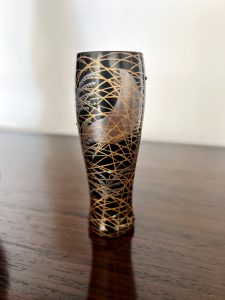涼しさを感じられる絵柄のお品です(愛知県名古屋市千種区姫池通 骨董買取 古美術風光舎)
2024.07.23
皆さまこんにちは。スタッフHでございます。
朝から強い日差しが容赦なく照りつけていますね。
せめてもの癒しに涼しげなお品を紹介いたします。
こちら茶道における「茶箱点前」の道具の一つである「茶筅筒(ちゃせんづつ)」と呼ばれるものです。
江戸時代の品で、三日月や秋草の蒔絵が施されています。よく見ると小さな粒銀がちりばめられ、小さな茶筅筒の中に幻想的な世界が広がっています。

茶箱とは茶道で使われる長さ20cmほどの長方形の箱で、お茶を点てる道具が一式収まった携帯用の箱です。
その中で茶筅筒は茶筅を安定させるため、また他の道具の水濡れを避けるために茶筅を収納する筒です。竹でてきた柔らかい穂先が萎んで、この細い筒にすっぽりと収まります。
裏千家の茶箱点前には季節に応じて、花点前(春)、卯の花点前(夏)、月点前(秋)、雪点前(冬)があります。風光舎の茶筅筒は月点前で使われたのでしょうか。
茶箱の歴史は古く、千利休が野外でお茶を楽しむ野点に使ったり、旅先にお茶道具一式を入れて持ち運んだようです。
江戸時代後半、裏千家11代家元の玄々斎が利休形の茶箱を元に茶箱点前を創案したとされます。卯の花点前は雪月花のお点前を簡略化した茶箱のお稽古の最初に習うお点前で、13代円能斎が多少の改良を加え現在のお点前になったといわれています。
小箱から一つ一つ道具を取り出していき、終わりには綺麗に収まっていく様は流麗で無駄な動きがなく、見ているだけでも気持ちのいいお点前です。場所を選ばずに楽しめるのはいいですね。
ちなみに茶筅についてですが、日本国内で販売されている茶筅のうち国産のものは約3割。そしてそのほぼ全てが奈良の高山産だそうです。高山茶筅の歴史は室町時代後期まで遡ります。農業の傍ら茶筅づくりの技術を受け継ぎ、地名を「鷹山」から「高山」に改め茶筅づくりを続けてきました。高山茶筅を家業とするのは18軒だそうです。
茶筅づくりは一子相伝で伝えられてきたと言います。かなりの手先の器用さが求められる気がするのですが…。
薄茶を点てるなら、穂の数が多い「80~100本立」が綺麗な泡がたちやすいそうですが、穂先が早く摩耗しやすくなる側面もあるため、80本立がおすすめだそうです。
また少ないお湯で抹茶を練る濃茶では、ダマが残らずしっかり粘土を出すために、穂先がしっかりしている穂の数が50本以下の「荒穂」で点てます。
流派によっても使用する茶筅が変わるようで、裏千家や江戸千家では白竹でできた穂先が内側に曲がった形状のもの、表千家は赤茶色の煤竹、武者小路千家では紫竹で穂先がまっすぐな茶筅が使用されるなど素材や形状も様々なようです。
忙しい日々、静かにお茶をゆっくり点てる時間をあえて作るのもいいかもしれませんね。
それでは、また次の機会に。
Hello everyone. This is Staff H.
The strong sunlight has been shining on us mercilessly since this morning.
I would like to introduce a cool item to soothe you at least.
This is a chasen tsuzutsu, one of the utensils used in the tea ceremony.
It was made in the Edo period and is decorated with maki-e lacquer of crescent moons and autumn grasses. If you look closely, you can see small grains of silver scattered throughout the small tea whisk barrel, creating a fantastical world inside.
A tea box is a rectangular box about 20cm long used in the tea ceremony and is a portable box that contains a set of utensils for making tea.
The Chasen tsuzumi is a tube that holds the Chasen in order to stabilize it and to prevent other utensils from getting wet. The soft tip of the bamboo whisk fades and fits completely into this narrow tube.
Urasenke’s tea box tea ceremony includes Hana-temae(spring), Unohana-temae (summer), Tsuki-temae (autumn), and Yuki-temae (winter) according to the season. Was Fukosha’s Chasen-temae for Tsuki-temae?
The history of the tea box is long, and it seems that Sen no Rikyu used it for nodate (tea ceremony in the open air) and carried a set of tea utensils with him when he traveled.
In the latter half of the Edo period (1603-1867), the 11th Iemoto of the Urasenke School, Gentzai, is said to have invented the tea box tea ceremony based on the Rikyu-shaped tea box. Unohana-temmae is said to be a simplified version of the Setsugetsuka-temae, which is learned at the beginning of tea box practice, and was slightly modified by the 13th Ennosai to become the current style.
It is said that Ennosai the 13th added some improvements to it and made it into what it is today. It is nice to be able to enjoy it in any place.
By the way, about 30% of all tea whisks sold in Japan are made in Japan. And almost all of them are made in Takayama, Nara. The history of Takayama Chasen goes back to the late Muromachi period. The family inherited the technique of making tea whisks while farming, changed the name of the place from “Takayama” to “Takayama” and has continued to make tea whisks. It is said that there are only 18 families that make Takayama Chasen as their family business.
It is said that the art of making tea whisks has been handed down from one generation to the next. I have a feeling that it requires a great deal of dexterity.
If you want to make thin tea, it is said that “80 to 100 whisks” with a large number of whisks will produce beautiful froth, but the whisk with 80 whisks is recommended because the whisk tips tend to wear out quickly.
For Koicha (thick tea), in which matcha is kneaded with less hot water, “Araho” whisks with less than 50 tips are used in order to produce a firm clay without lumps.
The material and shape of the tea whisk seem to vary depending on the school, with Urasenke and Edo Senke using white bamboo with the tip bent inward, Omotesenke using reddish brown sooty bamboo, and Mushakoji Senke using purple bamboo with a straight tip.
In our busy days, it might be a good idea to make time for a quiet and leisurely tea ceremony.
See you next time.
*******************
ご実家の整理やお片付けなどをされている方のご相談などが多くございます。
お片付けなどくれぐれもご無理のないようになさってくださいませ。
風光舎では古美術品や骨董品の他にも絵画や宝石、趣味のお品など様々なジャンルのものを買受しております。
お片付けをされていて、こういうものでもいいのかしらと迷われているものでも、どうぞお気軽にご相談下さいませ。
また風光舎は、出張買取も強化しております。ご近所はもちろん、愛知県内、岐阜県、三重県その他の県へも出張いたします。
まずは、お電話お待ちしております。
愛知県名古屋市千種区姫池通
骨董 買取【古美術 風光舎 名古屋店】
TEL052(734)8444
10:00-18:00 OPEN
#出張買取#骨董#古美術#骨董品#絵画#版画#茶道具#刀剣#彫刻

